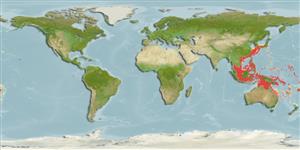Bivalvia |
Cardiida |
Cardiidae
Environment: milieu / climate zone / गहराई सीमा / distribution range
पारिस्थितिकी
; गहराई सीमा 0 - 45 m (संदर्भ 75831), usually 10 - ? m (संदर्भ 104607). Tropical
Indo-Pacific.
Length at first maturity / आकार / Weight / Age
परिपक्व अवधि: Lm ? range ? - ? cm
Found intertidal in mud and sand (Refs. 53, 104607). Depth estimate based on Family (Ref. 108635). Also found subtidal (Ref. 75840). Discretely motile surface deposit feeder (Ref. 125928).
Life cycle and mating behavior
परिपक्व अवधि | पुनरुत्पत्ति | मछलीऔ का अंडे देना | Eggs | Fecundity | Larvae
Members of the class Bivalvia are mostly gonochoric, some are protandric hermaphrodites. Life cycle: Embryos develop into free-swimming trocophore larvae, succeeded by the bivalve veliger, resembling a miniature clam.
Leung, K.F. and B. Morton 2000 The 1998 resurvey of the subtidal molluscan community of the southeastern waters of Hong Kong, six years after dredging began and three since it ended. pp. 553-617 In B. Morton (ed.) The Marine Flora and Fauna of Hong Kong and Southern China V, Proceedings of the Tenth International Marine Biological Workshop, Hong Kong, 6-26 April 1998. Hong Kong University Press. (संदर्भ 77724)
IUCN Red List Status
(संदर्भ 130435: Version 2025-1)
CITES status (संदर्भ 108899)
Not Evaluated
CMS (संदर्भ 116361)
Not Evaluated
Threat to humans
Human uses
| FishSource |
साधन
अधिक जानकारी
Trophic EcologyFood items (preys)
संघटक आहार
आहार खपत
परभक्षी
Population dynamicsबाढ़Max. ages / sizesLength-weight rel.Length-length rel.Length-frequenciesMass conversionबहुतायत Life cycleपुनरुत्पत्तिपरिपक्व अवधिFecundityमछलीऔ का अंडे देनाEggsEgg developmentLarvae PhysiologyOxygen consumption
Human RelatedStamps, coins, misc.
इंटरनेट स्रोत
Estimates based on models
